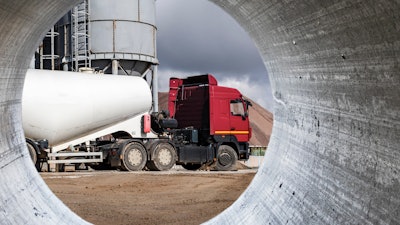
Concrete is one of the most consumed products on earth. Even with these extreme numbers, the global cement market is expected to increase to $481.73 billion by 2029, more than 5.1% annual growth between now and then. Unfortunately, the current use of cement across the globe is responsible for the release of more than 4 billion tons of carbon dioxide annually.
In an effort to combat environmental problems, the federal government has implemented a series of rules and regulations on the industry. This has drastically impacted the ability of companies to meet the growing need for this vitally important product for the construction of our bridges, dams, roads, and structures across the world. As global emissions regulations begin implementation in the U.S. and beyond, it is important that companies are able to streamline their product to meet demand fluctuations.
What Are Demand Fluctuations & Why Do They Happen?
Cement demand fluctuations are the changes in demand for cement that can occur due to a number of factors, including economic conditions, weather patterns, population growth and development, and technological advances. Cement demand fluctuations can be good or bad for builders and concrete producers, depending on their impact on the overall market.
There are many reasons why cement demand fluctuations happen, but some of the most common reasons are related to the economy, weather conditions, and population growth.
When the economy is doing well, people tend to purchase more new homes and buildings. This increase in construction can lead to an increase in cement demand since more cement is needed to build these new structures. However, when the economy starts to decline, people might begin to remodel or repair their existing homes and buildings, which can lead to a decrease in cement demand.
Additionally, weather conditions can also have a significant impact on cement demand. For example, a hot summer can cause residents in hotter climates to need more air conditioning and insulation, which can drive up cement demand.
Finally, population growth is also a factor. As more people move into cities, they often require more infrastructure — such as roads and schools — which can increase the demand for cement.
Four Ways Cement Companies Are Matching Demand
- Preparing for Demand Fluctuations: Builders need to be prepared for sudden changes in demand by having a contingency plan in place. This could involve stockpiling supplies of specific types of cement, working with suppliers to manage production more closely during high-demand periods, or even shutting down production if necessary.
- Adjusting Supply Levels: Cement producers can adjust their supply levels to match fluctuating demand by adjusting production rates, adding new capacity, or closing down plants when necessary. This approach can help ensure that products are available at the right time and in the right quantity and that prices remain fair for both consumers and producers.
- Coordinating Purchasing Activities: The purchasing sector can play a role in coordinating purchases between different companies to help avoid shortages and maintain stable prices. This is particularly important during peak demand periods when builders and concrete producers might need to order in bulk to avoid higher costs.
- Optimizing Product Mix: Manufacturers can adjust their product mix to match changing demand, which can help ensure that the right type of cement is available at the right time and in the correct quantity. By doing this, companies can reduce waste and improve efficiency.
Unfortunately, we are seeing companies across the globe struggle to meet peak demand for concrete. As a result, the industry is losing profit and experiencing challenges locally, as well as on a global scale.
Common Issues Concrete & Cement Manufacturers Face
At the C-suite level, the current stresses over inflation and ocean freight delays have drastically impacted the overall contribution margins for companies. On a global scale, emissions regulations are having a major impact on companies' storage capacity. They are also changing the availability of distribution centers needed to deliver cement, as well as trucks and mills. Should these trends continue, we can expect a major impact on the future product mix.
Given the high costs of petroleum coke, coal, and other essential inputs, we can expect the operating profit margins to decrease between 5% and 6% by 2023. The increased competition and moderate demand for the product are not helping these projections.
How Have These Issues Affected Sales and Operations Planning?
Regulations have changed how cement is produced, as it is now increasingly being outsourced to other countries that do not have to pay any attention to CO2 emissions. This means concrete factories must wait to import the product, which has a negative effect on lead times and makes supply-chain management fragile. Similar situations happened when China outsourced U.S. manufacturing in the automotive and semiconductor industries.
Materials such as cement, concrete, and bricks are more localized to markets as they are difficult and expensive to transport. This makes the pricing less competitive. There is a slower transfer of price fluctuations in these markets.
The government is imposing new limitations on high carbon-emitting building materials in major projects, affecting large government investments. The General Services Administration will now require contractors to use climate-friendly concrete and asphalt in all of their major projects. The new regulations will affect over 370 million square feet of real estate and more than $75 billion across all contracts annually.
Responding To Issues
Cement companies need to continuously work with retailers and end customers to determine demand changes. With this information, they can tweak the product mix down to the location level to drive sales, as well as profit and contribution margin.
When the cement supplier has better knowledge of needs, they would then be able to adjust inventory to prevent gaps in their cash flow. For example, when the supplier knows what products contractors need, how much is needed, and when it's needed, the inventory can then be used more efficiently. From sourcing product to distribution, all customer learnings need to be trickled down cross-functionally to ensure efficient and smooth end-to-end operations.
This, in turn, ensures that suppliers can meet end users’ needs much more easily, as supply chain delays will become less common, leading to improved costs and customer service. And when issues in the ordering process do arise, the healthy working relationship between supplier and client will make such issues easier to resolve.
In addition to learning the demand patterns, suppliers are finding benefits in utilizing artificial intelligence (AI). Using AI and regressors around gross domestic product, weather patterns, commodity prices, and various other economic indicators can help predict when demand changes are going to take place.
Machine learning (ML) has made it feasible to quantify data to make accurate demand projections, which would otherwise be impossible. For example, one of the leading cement manufacturers wanted to free up working capital investments and find a more efficient inventory management system. It was also struggling to create an optimal fleet of trucks to cater to increased demand while keeping investments under control.
ThroughPut’s AI helped the manufacturer save $1.1 million by eliminating 226,000 tons per year of excess inventory. This gave the cement company the ability to effectively ensure that AI-driven demand planning and allocation helped improve material flows while maintaining the same load on logistics with fully loaded trucks. Overall, the AI helped the company identify supply chain efficiency opportunities and working capital improvements at global and local scales through result-oriented KPIs.
In turn, this helped reduce and eliminate existing inefficiencies and identified savings opportunities to pay for an additional inbound logistics fleet of trucks. With the help of AI, the client was also able to improve its customer service levels and logistics spend using a better allocation by SKU, resulting in more than $1 million in savings and working capital improvements, as well as a 20% performance improvement in its yield margins.
The client now uses end-to-end data, made available by AI, to make its supply chain more efficient and productive by understanding downstream demand and what is needed to produce its money goals with its newly acquired setup for faster turn-around amidst dynamic lead times.
With the help of AI, demand planners can also automate data analysis and predict potential disruptions in advance. Demand planners are also using AI to predict changes at scale and on time rather than reacting to unexpected disruption. With this automation, demand planners can shift their focus from reactionary to strategic planning, even during changes.
This shift in focus from reacting to making proactive changes to strategic planning will give cement suppliers an edge against other suppliers in the market.
About the author
Ali Hasan R. is the co-founder and CEO of ThroughPut Inc.. Ali’s experiences in onshore and offshore supply chain management in the U.S., Russia, United Arab Emirates, Saudi Arabia, Pakistan, Bahrain, and Yemen have produced results for customers’ ongoing work, which is now featured at some of the world’s most recognized brands.



















